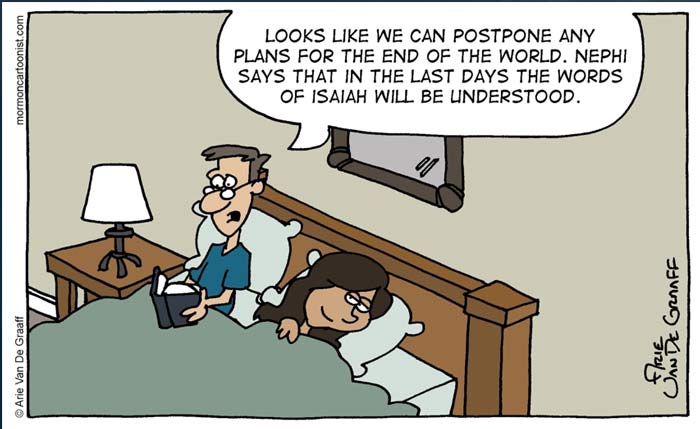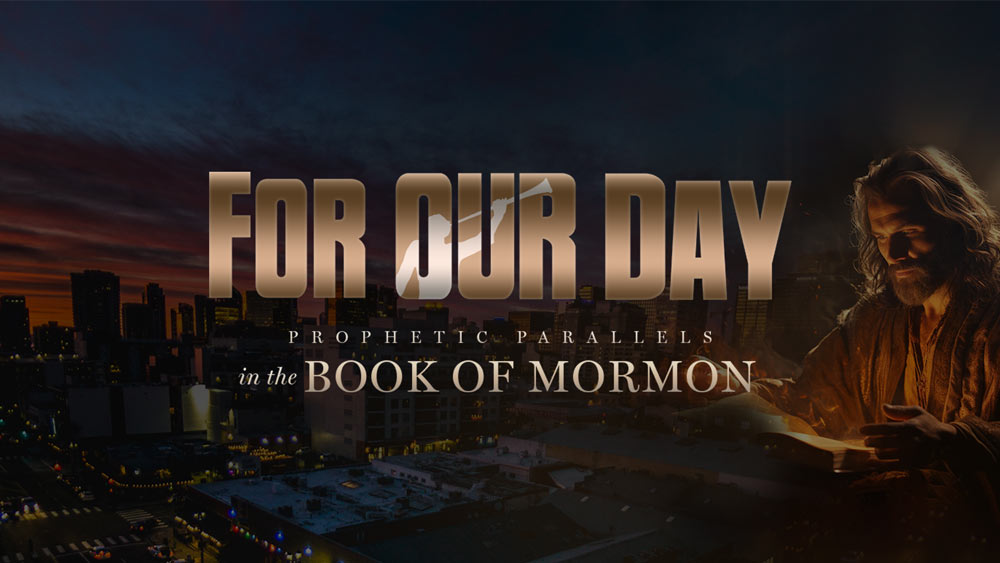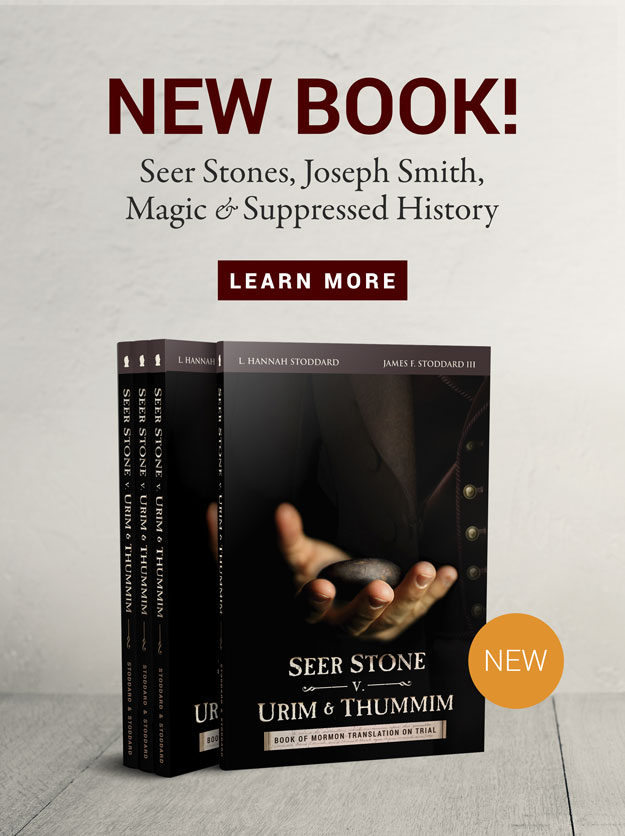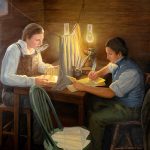For Our Day Parallel
Promise: Righteous groups are led out from the wicked to a promised land where the freedom of worship according to conscience is possible.
Book of
Mormon
Lehites/Mulekites travel to America, c. 589 B.C.
For
Our Day
Gentiles migrate to America, c. 1607 – 1780 A.D.
In lieu of a video podcast this week, we have a number of free video clips below from the documentary “For Our Day: Covenant on the Land,” and other media delving into the parallels between Lehi’s family and the early American colonists whom Nephi saw in vision.
There is also a video podcast included below in the “Set the Course” section titled “Simplifying Isaiah,” covering the Isaiah passages in 1 Nephi 19-22. Enjoy!
True and Faithful to His Calling
To be separate from the world.
Hunted, driven from the North Land,
Joined in cov’nant for His Word.
Born of peril, storming tempest,
Sun, nor moon, nor star canst see.
Yet Lord thou canst surely save us,
Thou hast called us to be free.
— Verse 2, Faithful Footsteps
James F. Stoddard III
The Lord has led several groups of covenant people to the Promised Land of America. Two of these that we have a significant record of are the Lehites and the Pilgrim Separatists seen by Nephi in vision (1 Nephi 13). By carefully studying the dealings of the Lord with these two covenant groups, you will see that the similarities are stunning.
In this lesson, we will focus on the history of Separatist Pilgrims who came to America in 1620 aboard the Mayflower, after fleeing persecution in Europe. We will quote extensively from Of Plymouth Plantation, the journal of one of the most prominent Pilgrim leaders, William Bradford. While we will primarily focus on the Pilgrims, please note that if you study the Scottish Covenanters, the French Huguenots, the Pennsylvania Quakers, or the Massachusetts Puritans, you can also find identical parallels!
Parallel #1 — Living in Apostasy
Lehi and the other faithful saints living at Jerusalem were part of a small group surrounded by a degenerate church and nation who claimed to be the Lord’s people.
The Pilgrims were a small minority of faithful families in the midst of public masses who knew very little of the true Master, Jesus Christ. The general public adhered to the creeds of a splintered church that revolted against the very God whom they claimed to revere.
Parallel #2 — Taking a Stand for Truth
Lehi and other prophets were called by the Lord to stand alone and cry repentance to a hardened and unfaithful populace.
The Pilgrims and other Reformers were enlightened by the Spirit of God, and standing for the Truth, proclaimed the Lord and His rejected scriptures.
Parallel #3 — Martyrdom
The wicked Jews sought the life of Lehi and the prophets, the latter often being tortured or killed.
Many of the Pilgrims and Reformers were martyred for adhering to conscience. Others were hunted, driven and suffered relentless persecution.
Parallel #4 — Receiving a Promised Land
Lehi was protected by the Lord and, because of his righteousness, was assured a Promised Land both in this life and the next.
The Pilgrims also understood that America is a covenant land and that those possessing this land must serve the God of this land who is Jesus Christ. These Pilgrim Fathers kept these covenants and were given this Land of Promise for an everlasting inheritance. (1 Nephi 13:15)
Parallel #5 — Sacrificing All Property
The Lehites were required to leave all of their property and possessions to obtain their promised blessings.
The Pilgrims similarly forsook all, considering the things of this world as dross.
Parallel #6 — Preparation Before Coming to America
The Lehites spent eight years in the wilderness in preparation for their journey to America.
The Pilgrims first escaped to Holland and after a testing period of 11 years were guided to the New World.
Parallel #7 — Saved from a Violent Storm
Nephi was inspired to build a ship, and after surviving a violent storm—caused by unfaithfulness—was then led to America with his family.
The Pilgrims were protected from a violent storm on the sea (while escaping from England to Holland). Later, they were blessed to make their voyage safely to America on the Mayflower.
Parallel #8 — Praising God
Upon reaching the new land both groups praised the Lord who had preserved them.
Parallel #9 — Carrying the Bible & the Brass Plates
The Lehites carried with them a record of scripture, the Brass Plates, containing much of the word of God from the Creation of the World and the covenants made by the Lord to His people. This record became the foundation of the Nephite nation both temporally and spiritually.
The Pilgrims bore the Bible, a record containing much of the word of God from the Creation of the World as well as many sacred covenants. The Bible was “a record like unto the engravings which are upon the plates of brass” (1 Nephi 13:23). The Bible became the foundation of the greatest nation on earth in modern times and the basis of its institutions. It is not an accident that these two groups and nations parallel each other in these and many other important characteristics.
Now that we’ve seen an overview of the parallels,
let’s dive in for more details!
Quick Links to Resources Below!
1
Persecution
As with Lehi, as the Pilgrims diligently followed the commandments of God and taught that the former Church had become corrupt, harassment followed. The leaders, both political and religious, continued to severely persecute those who were true followers of the Lord. Finally:
. . . at length they began to persecute all the zealous reformers in the land, unless they would submit to their ceremonies and become slaves to them and their popish trash, which has no ground in the word of God, but is a relic of that man of sin.
Of Plymouth Plantation, 5. Tweet
As time progressed, the persecution became so intense that the Pilgrims had no choice but to separate themselves from those who desired their destruction. Many of the histories are graphic in their detail of the persecution and torture:
They were hunted and persecuted on every side, until their former afflictions were but as fleabitings in comparison. Some were clapped into prison; others had their houses watched night and day, and escaped with difficulty; and most were obliged to fly, and leave their homes and means of livelihood. . . . For these reformers to be thus constrained to leave their native soil, their lands and livings, and all their friends, was a great sacrifice, and was wondered at by many.
Of Plymouth Plantation, 8. Tweet
Learn more about William Bradford and William Brewster, two of the most influential Separatist Pilgrim leaders!
2
Leaving their Home
Again, similar to Lehi and his family, the Lord requires the faithful to leave their homes and wealth before coming to the Promised Land. These sacrifices are clearly symbolic of our need to sacrifice all earthly things to enter into the true Promised Land, which is the Heavenly Kingdom of God. Additional requirements include placing the Lord before estates, employment, friends and even family. Lehi and his family were required “to leave the land of their inheritance, and their gold, and their silver, and their precious things” (2 Nephi 2:11, 3:16). The Pilgrims were required “to leave their native soil, their lands and livings, and all their friends.” (Of Plymouth Plantation, 9)
As was the case with Lehi, this journey was not easy. Faith is born of adversity and sanctification comes from blood. One experience illustrates the depth of sacrifice that is required.
A group of the Pilgrims had hired a ship to transport them in an attempt to escape from England to Holland. The master of the ship allowed them to load all of their earthly belongings onto the vessel, and then betrayed them into the hands of the authorities. After being rifled and ransacked—a harrowing ordeal for the women who were searched and touched inappropriately—they were dragged through the community as the townspeople jeered and taunted on every side. After months of imprisonment most were finally released, while the Pilgrim leaders were bound and held over for yet more humiliation and examination.
The following spring another attempt was made, this time with a Dutch ship. Richard “Little Bear” Wheeler tells the story while dressed in traditional 17th-century clothing!
If you are unable to watch the above video, a summary of the story is included below:
The Pilgrims were to meet the ship between Grimsbe and Hull in a large common. The women and children were sent by a small boat and the men traveled by land each arriving a day before the ship. The women were very sick and the boat was moved to low water near an opening.
When the ship arrived the following morning, the boat containing the women and children was fixed on the land and could not move. The captain of the ship, realizing that it would be some time before the women and children could be loaded, commenced loading the men first. Just as the loading of the men was finished,
. . . the master espied a great company, both horse and foot, with bills, and guns, and other weapons; for the country was raised to take them. The Dutchman seeing that, swore his countries oath, "sacrament," and having the fair wind, weighed his anchor, hoisted sails, and away. But the poor men which were got aboard, were in great distress for their wives and children, which they saw thus to be taken, and were left destitute of their helps; and themselves also, not having clothes to shift them with, more then they had on their backs, and some scarce a penny about them, all they had being aboard the barke [women’s boat]. It drew tears from their eyes, and anything they had they would have given to have been ashore again; but all in vain, there was no remedy, they must thus sadly part.
Of Plymouth Plantation, 11 Tweet
The women and children were left defenseless before the authorities as their husbands were taken out to sea.
. . . pitiful it was to see the heavy case of these poor women in this distress; what weeping and crying on every side, some for their husbands, that were carried away in the ship as is before related; others not knowing what should become of them, and their little ones; others again melted in tears, seeing their poor little ones hanging about them, crying for fear, and quaking with cold. Being thus apprehended, they were hurried from one place to another, and from one justice to another, till in the end they knew not what to do with them . . .
Of Plymouth Plantation, 11 Tweet
The women and children were taken from one constable to the next enduring great ridicule and privation. The authorities could not decide what to do with them. They had no homes to return them to. They could not hold so many women and children in prison as they had not broken the law. They could not be released as the people would cry out. In the end the authorities tired of the situation and of necessity obtained their release.
3
Storm at Sea
Later, the men received their share of the trial as well. Shortly after embarking, a violent storm arose in which they did not see the sun, moon or stars for seven days. They were driven near the shores of Norway and the hearts of the captain and crew fainted with fear. The men, however, did not despair that the Lord could deliver them:
[with] fervent prayers they cried unto the Lord in this great distress (especially some of them,) even without any great distraction, when the water ran into their mouths and ears; and the mariners cried out, "We sink, we sink"; they cried (if not with miraculous, yet with a great height or degree of divine faith), "Yet Lord thou canst save, yet Lord thou canst save" . . .
Of Plymouth Plantation, 11-12 Tweet
Richard “Little Bear” Wheeler tells the rest of the story here:
As Nephi and his family were saved by faith from a violent storm at sea and led by God to the promised land, so the Pilgrims were protected and led to the New World.
4
Heavy Sacrifice
When the Separatist Pilgrims eventually made it to America, they again faced bleak and hopeless circumstances. The Mayflower arrived on the banks of Cape Cod on November 11, 1620, a month late, miles from their intended destination and with bitter winter weather about to set in. The first winter the Pilgrims endured in North America was devastating, as nearly half of their company died. We will never know, in this life, all of the great sacrifices made by these early colonists in coming to America, in preparing the way for each of us. But in the midst of the death and disease of the Pilgrim’s first winter, examples of heroism were seen.
5
Miracles & Preservation
As Lehi and his family journeyed to the Promised Land, they also faced starvation, hunger, and death. 1 Nephi 16 records the episode where Nephi breaks his bow and his brothers’ bows lose their spring. Only by relying on the Lord was Nephi able to find food to save his family from death.
The Separatist Pilgrims also faced starvation due to a severe drought which occurred three years after first setting foot in New England. Desperate, they set aside a day for prayer. The day started clear and dry as usual but approximately eight hours of prayer later, clouds began to gather. The Pilgrims retired and the following morning, gentle showers began.
God performed miracles for the Lehites and the Nephites. They were the children of Israel and they had a right, when they were righteous, to enjoy the providential hand of God. As modern Israel, we too can enjoy the same promises of protection and blessing when we are faced with dire need.
6
Why concern ourselves with the foundations of America?
Why were we given the record of Lehi and Nephi in the Book of Mormon? Why have prophets, ancient and modern, continuously taught concerning the early founders of America? These questions could likely be answered in many ways. Regardless of your race, nation, or culture, Lehi, Nephi and the Separatist Pilgrims serve as powerful role models of what it means to live in covenant with God. We are also a covenant people and our covenants can best be understood through prophetic history. The foundations of America (ancient and modern) hold the key in helping us build Zion today.
Interested in learning more? Check out the documentary, Monumental, by Kirk Cameron!
Set the Course
A significant portion of Nephi’s writings contain quotations from the Book of Isaiah in the Bible. Isaiah’s poetic language can sometimes appear overwhelming and even impossible to understand.
However, Nephi says that he “delighteth in plainness; for after this manner doth the Lord God work among the children of men.” (2 Nephi 31:3) Jesus Christ also later commanded the Nephites (and Latter-day Saints) “Yea, a commandment I give unto you that ye search these things diligently; for great are the words of Isaiah” (3 Nephi 23:1).
Nephi provides a perfect foundation and introduction in 1 Nephi 19-22. He quotes two chapters in Isaiah, and then provides a simple commentary. Using Nephi’s decoding of Isaiah, the following five-part series will walk through these chapters so simply that any member—especially beginners—will be able to approach the Isaiah chapters in the Book of Mormon with new confidence!
Simplifying Isaiah (1 of 5): Nephi's Commentary, 1 Nephi 22
Simplifying Isaiah (2 of 5): Worldwide Quest for the Lost Tribes! Historical & Cultural Evidence of the Scattering (Nephi's Commentary, 1 Nephi 22)
Simplifying Isaiah (3 of 5): Accomplishing Mission Impossible: The Marvelous Work and Wonder (Nephi's Commentary, 1 Nephi 22)
Simplifying Isaiah (4 of 5): Isaiah 48 (1 Nephi 20)
Simplifying Isaiah (5 of 5): Isaiah 49 (1 Nephi 21)
Embark on the Journey
Monthly “I Am a Latter-day Nephite” Theme!
I will covenant to maintain our rights and our religion.
Remember: While you absolutely may do every activity suggested if you would like, it is certainly not needed, nor are you limited by the ideas given here. Choose one or more that will work with your learning style, available time, or the group that you are working with. Even if you are an adult, don’t hesitate to choose an activity originally aimed at children—those can be the most fun!
Feel free to run with any other ideas that come to your mind! Allow the Lord to guide you in choosing the best activities for you. The ultimate goal is to engage with the material and become a “doer of the word.”
- If this is your first week here, welcome! Please review our Welcome & How to Join the Quest for some helpful information on how to use this resource. You may also want to check out the Embark on the Journey section of Lesson 1 for some activities that will be helpful in getting you started on this quest. In particular, you’ll want a journal, and perhaps the “I Am a Latter-day Nephite” resolution, and a fun Book of Mormon reading chart. Just start where you are in the year—don’t feel like you have to backtrack and do every lesson, but grab these helpful tools and you’ll be good to go from here!
- Create your own paper ship to remember the Nephi’s ship and the Mayflower using paper, wood dowels, cardboard, straws, and more. If creating a ship is hard, you can also purchase a kit from online. If using waterproof materials, test it out in water outside or in a bathtub and see if it works! You can even re-enact the storm at sea. Remember to upload a picture to social media and add #ForOurDay so we and others can see your creation!
- YouTube Tutorial: “How to Make a Paper Ship” (Version 1)
- YouTube Tutorial: “How to Make a Paper Ship” (Version 2)
- Reflect in your journal on the following questions:
- Why does it matter how America was founded in ancient or modern times?
- How is that relevant to your everyday life?
- What can we learn from these patterns as we prepare for the return of Jesus Christ and the establishment of Zion?
- Re-enact the story of the pilgrims and Nephi’s storm at sea for your family. You can use your phone to play sound effects of the storm at sea using the YouTube video link below. If you want to dress up, clothing and outfits can be created from old sheets, pillowcases, robes, and more. Characters could include guards, pilgrim fathers and mothers, and dolls for infants. If you would like, film your production and post it online or on YouTube for others to inspire them with these stories from our Israelite heritage!
- Learn a little bit about what it would have been like to be a Pilgrim. Here are a few fun resources for all ages:
- Mayflower Infographic and How 102 Pilgrims Crammed Inside the Mayflower
- Learn how to talk like a Pilgrim
- Eat like a Pilgrim – recipes to make your own Pilgrim dinner
- Riddles and word puzzles were a fun way to pass the time. Here are some 17th-century riddles to stump your friends!
- Create or buy your own bow and arrow set. Hunt for food around and in your home like Nephi using stuffed animals or targets, and end the day with a special surprise treat for dinner to remember that God saved both Lehi’s family and the pilgrims/puritans from starvation. See who in the family can best recall the story of the broken bow and the pilgrims.
- Create or buy a large globe or map and trace the journey of the pilgrims from England, to Holland, to America. If using a map, print out pictures of the pilgrims, guards, the Mayflower, England, or Indians and tape them to the map. You can also create a map with poster board, paper, or a whiteboard.
- Buy the book, Lehi’s Family Travels to the Promised Land and read it together as a family.
- If you choose to download or purchase a designed cardstock version of the “I’m a Latter-day Nephite” resolution, you may want to post it where you will see it every day—on the fridge or your mirror, for example. Ponder on this month’s statement “I will covenant to maintain our rights and our religion.”
- In D&C 101:77-80, the Lord counsels Joseph Smith on how he should respond to the persecution of the Saints by saying, “And again I say unto you, those who have been scattered by their enemies, it is my will that they should continue to importune for redress, and redemption, by the hands of those who are placed as rulers and are in authority over you According to the laws and constitution of the people, which I have suffered to be established, and should be maintained for the rights and protection of all flesh, according to just and holy principles… And for this purpose have I established the Constitution of this land, by the hands of wise men whom I raised up unto this very purpose.” The “just and holy principles” laid out in the Preamble of the Constitution of the United States are the Founding Fathers’ idea of what a government should provide for its people. This Book of Mormon Central article discusses these seven principles. Do you feel these principles are upheld today? Why or why not?
- Read or listen to Dallin H. Oaks’ talk from the April 2021 General Conference, “Defending Our Divinely Inspired Constitution.” Discuss with your family or record in your journal what rights you have. Consider the rights that are protected by your country’s founding documents. What could your life look like if you didn’t have those rights? Do you feel that your country’s government has maintained those rights since its founding document? Why or why not?
Unless otherwise stated, reference to any products, services, hypertext link to third parties or other information by trade name, trademark, supplier or otherwise does not constitute or imply its endorsement or sponsorship by us. They are for convenience only.
All Hands on Deck
- Pray each morning this week for the Lord to give you an opportunity to share your thoughts on the Book of Mormon and/or what you’ve learned this week with someone.
- Join the For Our Day community on social media for uplifting shareable content, ideas on how to implement For Our Day in your home and classes, and to connect with others on the journey. You can find us here: Facebook, Instagram, and YouTube.
- This week didn’t have a video going over the parallels between the Pilgrims and Lehi’s family, so you get to make one! Grab your cellphone camera and make this week’s video as if you were hosting a For Our Day podcast. Make it as elaborate or simple as you would like and share it on social media. Be sure to add #ForOurDay so we can see it. Post your video by Thursday night and you could be featured on our Facebook and Instagram pages!









